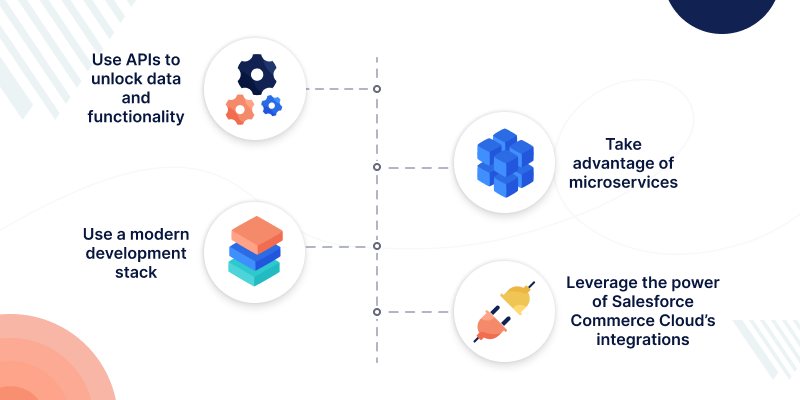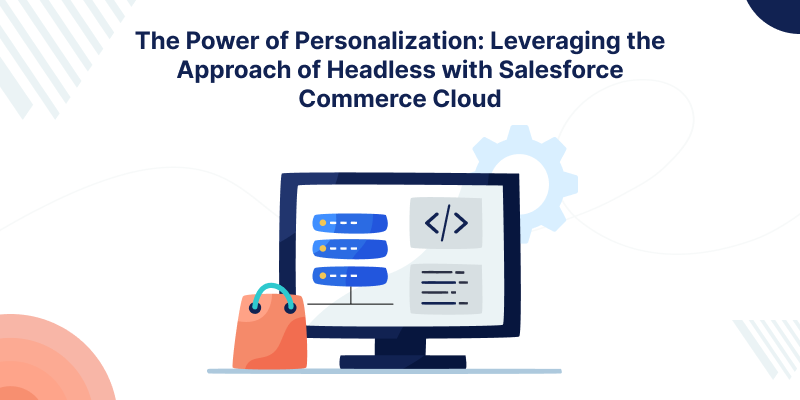The Power of Personalization: Leveraging the Approach of Headless with Salesforce Commerce Cloud
Welcome to the world of personalization, where every click, swipe, and purchase is carefully tailored to you. In today’s fast-paced digital landscape, customers demand a seamless shopping experience that feels truly unique and catered to their needs. And that’s where the power of personalization comes in – it has become an essential tool for businesses looking to stand out from the crowd and make a lasting impression on their customers. In this blog post, you will explore how leveraging the headless approach in Salesforce B2C Commerce Cloud can take your personalization game to new heights. Get ready to revolutionize your online shopping experience!
Introduction to Headless Commerce with Salesforce Commerce Cloud
Headless commerce is a hot topic in the eCommerce world. It’s a decoupled approach to eCommerce that allows for more flexibility and easier integration with third-party applications.
Salesforce Commerce Cloud is providing a headless commerce solution. It’s a platform that provides merchants with the ability to personalize the shopping experience for their customers.
The power of personalization is key when it comes to headless commerce. By leveraging the headless approach, merchants can provide their customers with a truly personalized shopping experience.
There are many benefits to using Salesforce Commerce Cloud for headless commerce, including the ability to:
- Personalize the shopping experience for each customer
- Easily integrate with third-party applications
- Provide customers with a seamless shopping experience
- Leverage the power of artificial intelligence (AI) and machine learning (ML)
- Utilize advanced analytics to gain insights into customer behavior
- Create a single view of the customer across multiple channels.
With Salesforce Commerce Cloud, merchants can quickly and easily create a headless commerce solution that meets their specific needs. It allows them to provide their customers with an unmatched shopping experience.
How Is Headless With Salesforce Commerce Cloud Possible Using The PWA Kit?

Headless Commerce with Salesforce B2C Commerce Cloud using the Progressive Web App (PWA) Kit is an innovative and powerful combination that enables businesses to deliver exceptional shopping experiences across various devices and platforms.
Let’s explore how this integration works and the benefits it offers:
-
-
PWA – Progressive Web App
PWAs are web applications that leverage modern web technologies to deliver an app-like experience to users. They can be accessed through a web browser without the need to install from an app store. PWAs offer fast loading times, offline access, push notifications, and a responsive design for an optimal user experience.
-
Salesforce Commerce Cloud (SFCC)
SFCC is a robust and scalable eCommerce platform that provides comprehensive tools for managing product catalogs, inventory, promotions, and customer data. It serves as the back-end engine for eCommerce operations.
-
Headless Commerce Integration
The integration between SFCC and PWA Kit follows a headless commerce approach. In this architecture, the front-end presentation layer (PWA Kit) is decoupled from the back-end commerce functionalities (SFCC). The PWA Kit communicates with SFCC through APIs to fetch product data, pricing, and other essential information.
-
Enhanced User Experience
PWA Kit enhances the user experience by providing a smooth and fast shopping interface. With features like instant loading, smooth animations, and intuitive navigation, customers enjoy an app-like experience directly on their browsers, regardless of the device they are using.
-
Offline Access and Low Data Usage
PWAs enable offline access, allowing users to continue browsing and shopping even when they have limited or no internet connectivity. Additionally, PWAs are designed to use minimal data, making them ideal for customers with slow internet connections or data restrictions.
-
Improved Conversion Rates
The combination of headless commerce and PWA Kit results in improved conversion rates. The faster loading times and frictionless experience reduce bounce rates and encourage customers to complete their purchases.
-
SEO-Friendly
PWAs are SEO-friendly and can be easily indexed by search engines. This ensures that your storefront’s content is discoverable, leading to increased organic traffic and better search engine rankings.
-
Cross-Platform Compatibility
PWA Kit allows your e-commerce store to work seamlessly across different devices, including desktops, tablets, and smartphones. Customers can access your store from any device without compromising on the user experience.
-
Cost-Effective Development
Building a PWA using the PWA Kit reduces development costs as compared to developing separate native apps for different platforms. This cost-effectiveness allows businesses to invest more in enhancing other aspects of the shopping experience.
-
Easy Updates and Maintenance
With the decoupled architecture, updates, and maintenance can be performed independently for the front-end and back-end. This results in a more straightforward and efficient process for rolling out new features and improvements.
-
In SFCC, PWA Kit has a complimentary feature that is managed runtime which helps to deploy and host the digital headless storefront. It is one of the core advantages of PWA KIt. The managed runtime automatically scales the digital store and makes sure it is running properly.
How to Leverage a Headless Approach in Your Salesforce Commerce Cloud Platform?
Salesforce Commerce Cloud is a cloud-based eCommerce platform that enables businesses to create highly personalized shopping experiences for their customers. The platform uses a headless approach, which means that the front-end and back-end of the system are decoupled, allowing for more flexibility and scalability. To take advantage of benefits, businesses need to leverage the headless approach in their Salesforce Commerce Cloud platform.
Here are some tips on how to do this:

-
- Use APIs to unlock data and functionality: The Salesforce Commerce Cloud platform provides a robust set of APIs that can be used to unlock data and functionality from the back-end system. This allows businesses to build custom front-ends that are tailored to their specific needs.
-
- Take advantage of microservices: The headless approach enables businesses to break down their eCommerce solutions into smaller, independent microservices. This makes it easier to scale and manage the overall solution.
-
- Use a modern development stack: To get the most out of the headless approach, businesses should use a modern development stack that includes technologies such as Node.js, React, and AngularJS. This will enable them to build rich, dynamic front-ends that are tailored to their needs.
-
- Leverage the power of Salesforce Commerce Cloud’s integrations: Salesforce Commerce Cloud includes several integrations with third-party services, such as payment gateways and shipping solutions. Businesses can leverage these integrations to quickly connect their eCommerce solution with external systems.
By leveraging the headless approach in Salesforce Commerce Cloud, businesses can create highly personalized shopping experiences for their customers and scale quickly and efficiently to meet changing customer demands. With the right strategies and tools, businesses can also take full advantage of this powerful platform.
How To Measure The Impact Of Personalization On Your Business?
Personalization has the power to transform the online shopping experience for customers and create loyalty for businesses. It can also lead to increased sales and conversion rates. With so many benefits, it’s no wonder that personalization is one of the most popular features in Salesforce Commerce Cloud.

But how do you measure the impact of personalization on your business?
There are a few key metrics you can track:
-
- Sales: Personalized recommendations can lead to more sales. Track the number of sales made with personalized recommendations to see how effective they are.
-
- Conversion rate: Personalization can also increase conversion rates. Track the percentage of visitors who purchase after seeing personalized recommendations.
-
- Engagement: Increased engagement is another benefit of personalization. Track how long visitors stay on your site and how many pages they view after seeing personalized recommendations.
-
- Loyalty: Personalization can create loyalty among customers. Track customer retention rates and repeat purchase rates to see how well personalization is working for your business.
Understanding the Benefits of Personalization
Salesforce Commerce Cloud is a powerful eCommerce platform that enables businesses to personalize the shopping experience for their customers. With SFCC, businesses can leverage a headless approach to customization. It also allows them to create custom experiences without dealing with the complexities of managing a traditional eCommerce infrastructure.
There are many benefits of using Commerce Cloud to personalize the shopping experience for your customers. By leveraging a headless approach, you can:
- Create custom experiences for your customers tailored to their individual needs and preferences.
- Deliver consistent experiences across all channels web, mobile, and social.
- Easily manage and update your personalized experiences as customer needs and preferences change over time.
- Scale your personalized experiences quickly and efficiently as your business grows.
Best Practices for Personalization
Salesforce Commerce Cloud provides the ability to personalize the shopping experience for their customers. By leveraging the power of the headless approach using the PWA kit, merchants can create a personalized experience for each customer, based on their individual needs and preferences.
Some best practices for personalization include:
-
- Identify your audience segments: To personalize the shopping experience, you first need to identify your audience segments. Consider who your customers are, what they need and want, and what motivates them. It will help you tailor the shopping experience to each segment.
-
- Define your goals: Once you know who your audience segments are, you need to define your goals for personalization. What do you want to achieve? Do you want to increase sales, improve customer satisfaction, or both? By defining your goals upfront, you’ll be able to measure the success of your personalization efforts.
-
- Collect data: Personalization is all about using data to understand your customers’ needs and preferences. Collect data from all touchpoints, including website visits, purchase history, customer service interactions, and more. This data will help you create a more complete picture of each customer and what they need from their shopping experience.
-
- Use technology: There are many different technologies available that can help you personalize the shopping experience. These include recommendation engines, real-time segmentation, predictive analytics, and more. Choose the right technology for your business and make sure it’s integrated into your eCommerce platform.
-
- Monitor and adjust: Personalization is an ongoing process. Monitor the results of your efforts and make adjustments as needed to ensure you’re providing the best possible shopping experience for each customer.
Salesforce AppExchange Consulting Profile
We are a business software development, consulting, and PDO firm with 13+ years of experience. We provide services for different Salesforce clouds such as Sales Cloud, Marketing Cloud, Health Cloud, Commerce Cloud, Service Cloud, and Experience Cloud. Also, we have a team of certified Salesforce developers and dedicated Salesforce Consultants. There are more than 10 applications that we have published on the Salesforce AppExchange.
Please visit our Salesforce AppExchange Consulting Profile to check our expertise and partner navigator achievements.
Conclusion
The opportunity to personalize the customer experience has never been greater than it is today. With the right headless approach, you can leverage Salesforce B2C Commerce Cloud to create a unique and engaging customer experience that will keep them coming back for more.
Headless Commerce with Salesforce Commerce Cloud using the PWA Kit. It also provides a winning combination that empowers businesses to create engaging, fast, and user-friendly shopping experiences across multiple devices and platforms. By leveraging the strengths of PWAs and the robustness of SFCC, companies can elevate their e-commerce strategy and drive customer satisfaction and loyalty to new heights.
For any queries, connect with our Salesforce Commerce Cloud Professional Team. They are available to assist you via email at [email protected] or via live chat. You can also get in touch for any kind of customization as per your business requirements.





Leave a Comment
Comments (0)